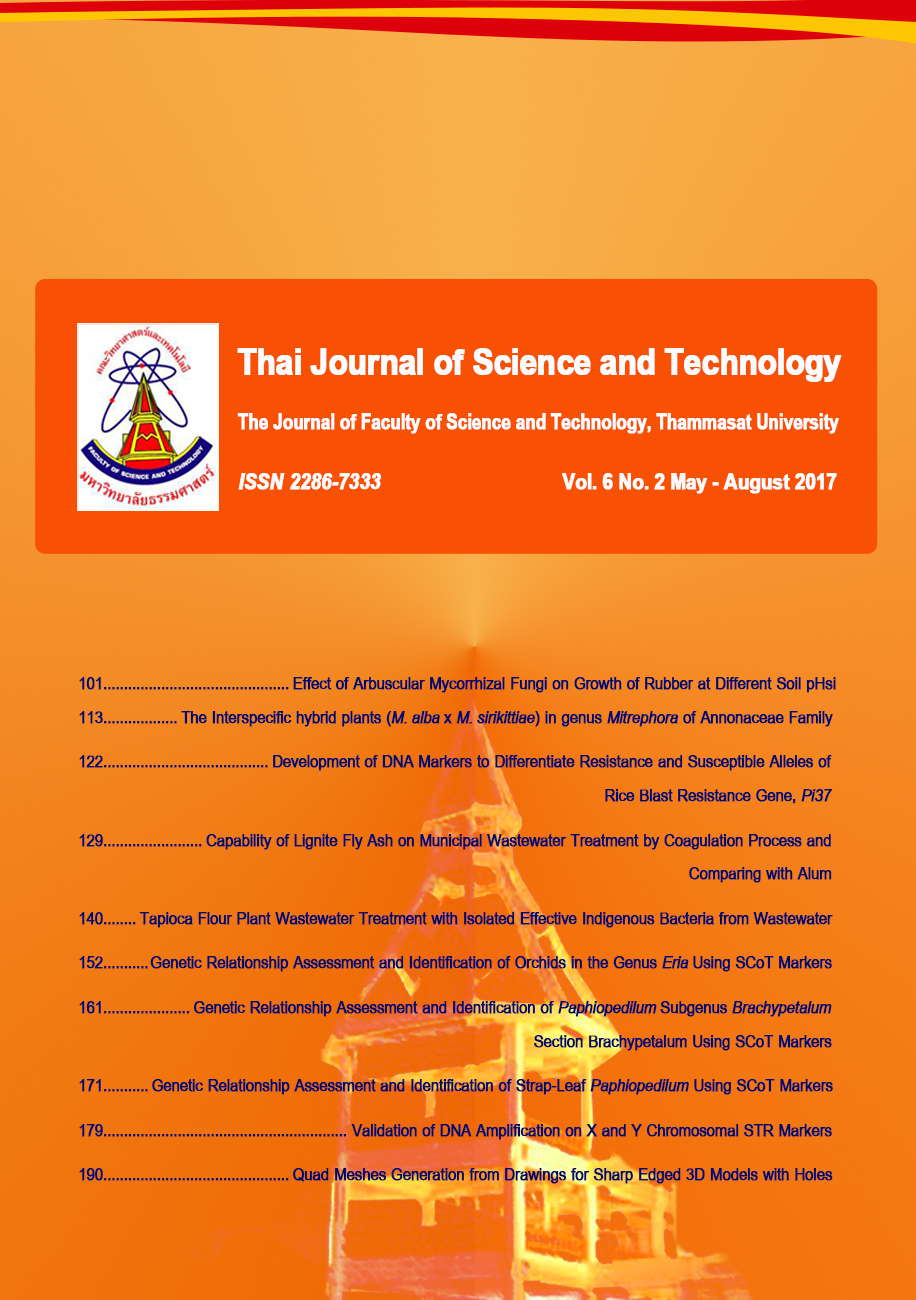การพัฒนาเครื่องหมายดีเอ็นเอสำหรับแยกแอลลีลต้านทานกับแอลลีลอ่อนแอของยีนต้านทานโรคไหม้ Pi37
Main Article Content
Abstract
บทคัดย่อ
โรคไหม้มีสาเหตุมาจากรา Magnaporthe oryzea ซึ่งเป็นตัวการสำคัญที่ทำให้สูญเสียผลผลิตข้าวทั่วโลก วิธีการที่เหมาะสมและประสบความสำเร็จในการป้องกันการสูญเสียผลผลิตจากโรคไหม้ คือ การลดความเสี่ยงของโรคระบาดโดยการปลูกข้าวสายพันธุ์ที่มียีนต้านทานโรค ยีน Pi37 เป็นหนึ่งในยีนต้านทานโรคไหม้ ซึ่งพบในข้าวพันธุ์ต้านทาน St. No. 1 มีตำแหน่งอยู่บนโครโมโซมที่ 1 มีความยาว 3,873 คู่เบส และแปลรหัสได้เป็นโปรตีนที่มีขนาด 1,291 กรดอะมิโน วัตถุประสงค์ของการศึกษาครั้งนี้เพื่อพัฒนาเครื่องหมายดีเอ็นเอสำหรับแยกแอลลีลต้านทานกับแอลลีลไม่ต้านทานของยีนต้านทานโรคไหม้ Pi37 ด้วยการเปรียบเทียบลำดับ นิวคลีโอไทด์ระหว่างแอลลีลต้านทานในข้าวพันธุ์ St. No. 1 กับแอลลีลไม่ต้านทานในข้าวพันธุ์นิปปอนบาเรย์ พบว่ามีลำดับนิวคลีโอไทด์ที่ต่างกันทั้งหมด 34 ตำแหน่ง ซึ่งมี 21 ตำแหน่ง ที่ทำให้เกิดการเปลี่ยนแปลงของกรดอะมิโน และมี 10 ตำแหน่ง ที่ตรงกับตำแหน่งจดจำของเอนไซม์ตัดจำเพาะ ผู้วิจัยจึงออกแบบไพรเมอร์ที่ครอบคลุมนิวคลีโอไทด์ลำดับที่ 741 (SNP741) ซึ่งเป็นตำแหน่งจดจำของเอนไซม์ FokI แล้วนำไปตรวจสอบข้าวพื้นเมืองไทยจำนวน 206 พันธุ์ พบว่ามีข้าวพันธุ์พื้นเมืองไทยจำนวน 146 พันธุ์ มีแอลลีลต้านทานของยีนต้านทานโรคไหม้ Pi37 คิดเป็นร้อยละ 70.87 ของข้าวที่ทดสอบทั้งหมด โดยพบแอลลีลต้านทานของยีนต้านทานโรคไหม้ Pi37 ในข้าวพื้นเมืองส่วนใหญ่จากภาคตะวันออกเฉียงเหนือ ข้อมูลที่ได้จากการทดลองในครั้งนี้สามารถนำไปใช้ประโยชน์ในการคัดเลือกพ่อแม่พันธุ์เพื่อพัฒนาและปรับปรุงข้าวพันธุ์ต้านทานโรคไหม้ในอนาคต
คำสำคัญ : ยีนต้านทานโรคไหม้; โรคไหม้ในข้าว; เครื่องหมายดีเอ็นเอ; ข้าวพื้นเมือง
Abstract
Rice blast disease caused by a fungal pathogen, Magnaporthe oryzea, is one of the most devastating diseases in worldwide rice production. The most prudent and feasible strategy to manage this disease is using disease resistance rice varieties. The Pi37 gene is one of blast resistance genes, presented in the rice cultivar St. No. 1. The Pi37 is located on chromosome 1, with transcript length of 3,873 bp. The deduced Pi37 open reading frame encodes a 1,291 residue polypeptide. The objective of this study was to develop the DNA markers to differentiate resistance and susceptible alleles of rice blast resistance gene, Pi37. Sequence of resistance allele from St. No. 1 was compared with sequence of susceptible allele of Nipponbare. Thirty-four polymorphic sites were identified; 21 polymorphic sites were missense mutations, whereas ten of them were at the recognition site of restriction enzymes including FokI. DNA markers were developed using nucleotide position SNP741 and used for screening rice blast resistance gene, Pi37, in Thai landrace rice varieties. From 206 landrace rice varieties, 146 varieties contained resistance allele (70.87 %). Most landrace rice from the Northeast of Thailand exhibited the Pi37 resistance allele. The information obtained from this study was very useful for the identification of parental lines with rice blast resistance gene in rice breeding program.
Keywords: rice blast resistance gene; rice blast disease; DNA marker; landrace rice
Article Details
บทความที่ได้รับการตีพิมพ์เป็นลิขสิทธิ์ของคณะวิทยาศาสตร์และเทคโนโลยี มหาวิทยาลัยธรรมศาสตร์ ข้อความที่ปรากฏในแต่ละเรื่องของวารสารเล่มนี้เป็นเพียงความเห็นส่วนตัวของผู้เขียน ไม่มีความเกี่ยวข้องกับคณะวิทยาศาสตร์และเทคโนโลยี หรือคณาจารย์ท่านอื่นในมหาวิทยาลัยธรรมศาสตร์ ผู้เขียนต้องยืนยันว่าความรับผิดชอบต่อทุกข้อความที่นำเสนอไว้ในบทความของตน หากมีข้อผิดพลาดหรือความไม่ถูกต้องใด ๆ


